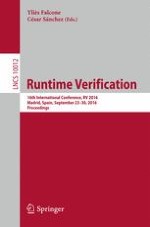This book constitutes the refereed proceedings of the 16th International Conference on Runtime Verification, RV 2016, held in Madrid, Spain, in September 2016. The 18 revised full papers presented together with 4 short papers, 3 tool papers, 2 tool demonstration papers, and 5 tutorials, were carefully reviewed and selected from 72 submissions.
The RV conference is concerned with all aspects of monitoring and analysis of hardware, software and more general system executions. Runtime verification techniques are lightweight techniques to assess correctness, reliability, and robustness; these techniques are significantly more powerful and versatile than conventional testing, and more practical than exhaustive formal verification.
